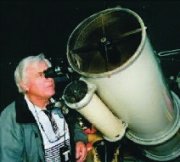 Astronomy is a unique science that cannot be studied in a typical laboratory setting here on earth. Instead, astronomers turn their attention and telescopes to the sky in order to study their subjects. Since professional astronomers often do not have the telescope time needed to follow a particular star or group of stars, the dedication of amateur astronomers is often an invaluable means of collecting information. Nowhere is this more true than in the field of variable star astronomy. Since 1911, thousands of amateur astronomers from all over the world and from all backgrounds have contributed observations, one at a time, to make up the more than 18 million data points housed in the AAVSO International Database!
Astronomy is a unique science that cannot be studied in a typical laboratory setting here on earth. Instead, astronomers turn their attention and telescopes to the sky in order to study their subjects. Since professional astronomers often do not have the telescope time needed to follow a particular star or group of stars, the dedication of amateur astronomers is often an invaluable means of collecting information. Nowhere is this more true than in the field of variable star astronomy. Since 1911, thousands of amateur astronomers from all over the world and from all backgrounds have contributed observations, one at a time, to make up the more than 18 million data points housed in the AAVSO International Database!
Anyone can be a variable star observer. All you really need to begin observing are:
• your unaided eyes, a pair of binoculars, or a telescope
• some variable star charts to help you navigate your way through the sky
• some basic instructions
• a little patience
For those interested in observing activity on our closest star, the sun, or a particular type of variable, such as the Eclipsing Binary and RR Lyrae type stars, or if hunting for novae, supernovae, or optical counterparts to energetic Gamma-Ray Bursts strikes your fancy, we have observing programs designed to help satisfy your appetite.
The AAVSO Mentor Program is available to all observers to assist newcomers in the methods and techniques of visual variable star observation, as well as CCD and PEP observation.

